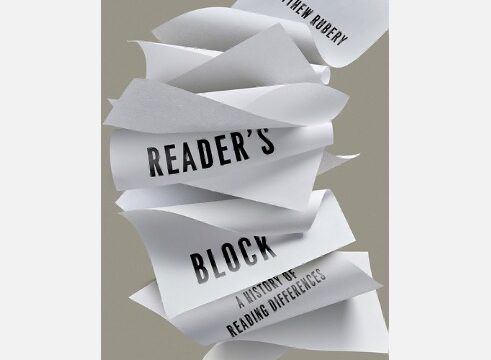Matthew Rubery. Reader’s Block: A History of Reading Differences. Redwood City, CA: Stanford University Press, 2022. 288 pages. ISBN 9781503632493. US $26.00 (cloth).
As seen in the recent Disability and Accessibility in Book Studies Bibliography published by SHARP News, there is not currently a lot of work published at the intersection of disability studies and book history; the scholarship that does exist primarily focuses on reading tools and techniques for people with visual impairments. Matthew Rubery’s Reader’s Block is the only book-length work at this intersection entirely focused on cognitive print disabilities. Rubery brilliantly connects these disciplines through an analysis of neurodivergent reading requirements, abilities, and habits. This book challenges neurotypical assumptions of reading and proposes a framework for discussing the act of reading that includes all reading abilities and all reading differences, whether the reader is disabled or nondisabled. Rubery notes in the epilogue that part of the motivation to write the book came from “the sense that [his] own peculiar reading habits set [him] apart from other people” (p. 207).
Rubery’s primary argument is that “there is no single activity known as reading. Instead, there are multiple ways of reading” (p. 1). Between making sense of “words jumping and dancing, flashing and swirling around the page” (p. 56), “perceiving the alphabet in luminous color” (p. 124), and “tracing the shapes of letters on the back of one’s hand or even (using the tongue) the roof of one’s mouth” (p. 30), he describes many methods of reading and treats them all equally throughout. Rubery’s inclusive definition of what counts as reading is refreshing and accessible.
There are three categories of print disability: visual, physical, and cognitive. Rubery focuses entirely on the last category. His six chapters each explore a different type of cognitive disability that can affect reading: dyslexia, hyperlexia, alexia, synesthesia, hallucinations, and dementia. This concentration on cognitive disabilities allows Rubery to explore a condition deeply and explain the effects on reading more thoroughly than if he had tried to include all three categories of print disability. Each chapter describes the condition and uses case studies, anecdotes (including those from memoirs of disabled readers), and medical research to explain how it impacts reading. Some notable examples include dyslexia memoirs from people who could not read what they had written and examples of readers with dementia who take pleasure in reading books though they have no memory of having read those books.
The first three chapters explore disabilities specific to reading: dyslexia, which is the most commonly known cognitive reading disability; hyperlexia, a savant talent related to reading, particularly at early ages, and which is often associated with autism; and alexia, which is the sudden loss of ability to read. The three lexias are specifically “reading differences,” to use Rubery’s term, and the descriptions of them build on each other nicely in this order. Together, these chapters provide a logical introduction to cognitive reading disabilities and the idea that not everybody decodes text in the same ways.
The latter three chapters focus on neurological disabilities that affect reading as well as other primary skills or traits that are more commonly associated with the disability: synesthesia, which is the experience of certain senses mixing their reactions, such as being able to taste colours or feel textures or temperature letters of the alphabet as you read them; hallucinations, the experience of seeing, hearing, smelling, tasting, or feeling things that are not present outside of your own mind; and dementia, which includes but is not limited to cases of Alzheimer’s, a disease primarily thought of as affecting memory and cognitive abilities. While these disabilities may not be as reading-specific as the lexias, they can affect reading just as significantly. Rubery’s descriptions and examples of reading with synesthesia, hallucinations, and dementia offer new insights on these cognitive conditions, which are just as important to understanding disabled reading as understanding the lexias.
This book is extremely valuable reading to anyone interested in disability studies, book history, and the science of reading and literacy. It is also useful for individuals with loved ones who have any of the conditions described in the book, as it can help them understand what their loved ones are experiencing. Those interested in a more general discussion of inclusive definitions of reading will benefit from the introduction and the epilogue, even if they are not interested in the detailed accounts of individual cognitive disabilities in the main chapters. (Don’t skip the epilogue, as Rubery revisits what a definition of reading could or should do and offers suggestions for future research in this area.) Overall, Reader’s Block is a must-read work on disabled book history, however you choose to read it.
Ellen Forget, University of Toronto


